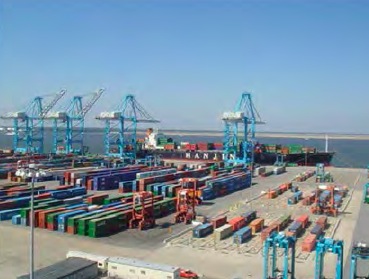AMERICAN ASSOCIATION OF STATE HIGHWAY AND TRANSPORTATION OFFICIALS
Executive Summary
 From the initial settlement of North America, through colonization and expansion, and to the present day, where and how we live has been determined in large part by waterborne transportation. Today, the United States relies on its Marine Transportation System, or MTS, for access to global markets and global products, and for domestic goods movement as an alternative to congested surface transportation.
From the initial settlement of North America, through colonization and expansion, and to the present day, where and how we live has been determined in large part by waterborne transportation. Today, the United States relies on its Marine Transportation System, or MTS, for access to global markets and global products, and for domestic goods movement as an alternative to congested surface transportation.
The MTS includes facilities on three coasts, the Great Lakes, and the Inland Waterways; it serves every state, either directly by water or indirectly via highway and rail connections; and it supports trillions of dollars in U.S. economic activity annually. The MTS evolved as a decentralized system comprised of many different stakeholders and responsible entities, with funding coming from a variety of public and private sources.
By many measures, the MTS is a great success; it has recovered from the recent recession and is handling near-record freight volumes. But looking forward, the MTS faces critical challenges: decades of insufficient system maintenance, which have left many parts of the MTS inoperable or on the brink of failure; excessive delays in navigation project delivery; inadequate and unpredictable funding for critically needed MTS improvements; lack of a national strategy to ensure the MTS provides the greatest benefit to the nation as a whole; and the fact that no locus of responsibility for the well-being of the MTS, and its failure or success.
To promote discussion and action, the American Association of State Highway and Transportation Officials (AASHTO) commissioned this Waterborne Freight Transportation report. The report describes the nature, extent, and critical role of the MTS, and offers a number of findings and conclusions for consideration, and possibly adoption, by AASHTO and others.
The main finding is this: with respect to waterborne freight, “business as usual” will lead to unacceptable further declines in MTS condition and performance, and to significant lost opportunities for our nation’s economy. A renewed national commitment to the MTS is urgently required, along with corresponding changes in how to plan for and fund the MTS. Options for change include: 1) Federal legislation to achieve full state-of-good-repair for MTS waterways, guarantee full utilization of funds collected for MTS improvements, and significantly improve the cost, speed, and reliability of MTS project delivery; 2) a new Office of Multimodal Freight, under the Secretary of Transportation, empowered and directed to eliminate the current balkanization of MTS planning, funding, and project delivery responsibilities, and advance sound planning and project implementation; and 3) promotion of best practices in MTS planning and investment at the state, regional, and local levels.
Water has been, and remains, a fundamental driving force in shaping the physical and economic development of the United States. Inland rivers and coastal routes were the continent’s primary transportation corridors, long before there were roads. Later, improved harbors and canals were the nation’s first improved freight corridors. Settlement patterns and industrial development naturally followed the coasts and waterways, because they provided access to marine resources and offered the only economically viable means of moving goods. Our first cities were port cities.
With advancing industry and technology and the rise of transcontinental railroads, the critical role of waterways did not diminish: rather, it took on a different and enhanced importance. Railroads built new connections between coastal and inland waterways, promoting the growth of interior cities and fueling America’s industrial revolution. Later as the U.S. highway network developed,population and production centers moved off the waterways but did not lose their need for waterborne transportation. Truck-only local services, combined rail-truck long-haul services, and advanced logistics practices evolved to ensure these growing inland markets remained connected to the water.
Today, America’s “Marine Transportation System” (MTS) remains a critical element of our domestic transportation infrastructure and our primary gateway for global trade. The MTS includes navigable waterways and public and private ports on three coasts (Atlantic, Pacific, and Gulf), the Great Lakes, and inland waterways. It also includes, by extension, the use of inland highway and rail connections that connect ports with inland markets, ensuring access to the water for shippers and receivers in all 50 states. The MTS includes 8,197 cargo-handling docks, 179 ports handling more than 250,000 tons annually, and 52 ports handling containers.
Download full report (PDF): Waterborne Freight Transportation
About the American Association of State Highway and Transportation Officials
www.aashto.org
“The American Association of State Highway and Transportation Officials is the voice for transportation and catalyst for organizational and technical excellence…AASHTO advocates transportation-related policies and provides technical services to support states in their efforts to efficiently and safely move people and goods.” – See more at: https://www.infrastructureusa.org/the-new-language-of-mobility-talking-transportation-in-a-post-recession-world/#sthash.UjBbgWzn.dpuf
Tags: AASHTO, American Association of State Highway and Transportation Officials, Freight, Ports, Water







 RSS Feed
RSS Feed